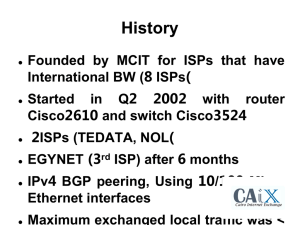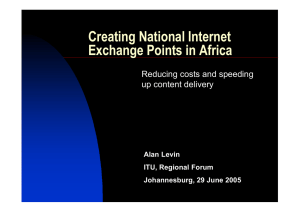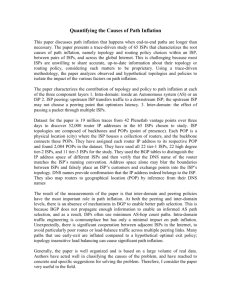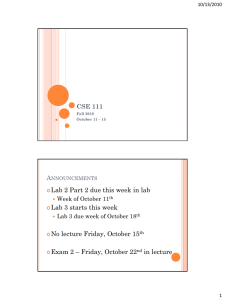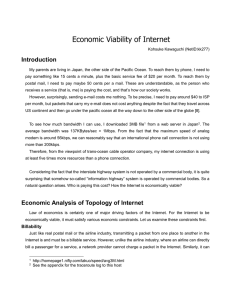QoS and VoIP :
advertisement
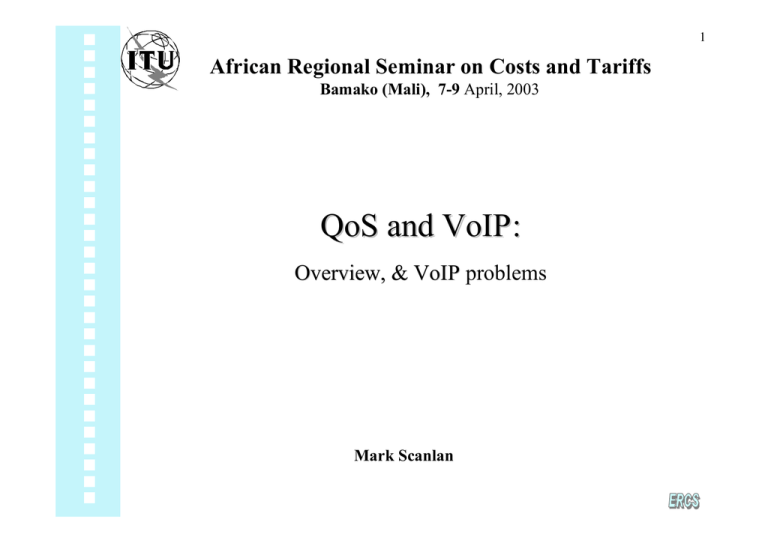
1 African Regional Seminar on Costs and Tariffs Bamako (Mali), 7-9 April, 2003 QoS and VoIP : Overview, & VoIP problems Mark Scanlan 2 Overview of the internet and IP (1) Ø The Internet is comprised of well over 100,000 networks which operate different software and hardware solutions on top of TCP/IP protocols. Ø This diversity is both a strength and a weakness. 1. It means that networks using non standardised equipment and operating with non standardised and diverse software, can connect and communicate with each other. 2. On the negative side this diversity makes it difficult to overcome technical (hardware and software) obstacles that stand in the way of seamless interoperability between networks. 3 Overview of the internet and IP (2) OSI and Internet protocol stack Layer 7 – Application Applications and Services Layer 6 – Presentation Layer 5 – Session TCP or UDP Layer 4 – Transport IP Layer 3 – Network Layer 2 - Data Link Layer 2 - Data Link Layer 1 - Physical Layer 1 – Physical Ø Applications and services protocols operate above at layers 5-7. Ø The technical obstacles that stand in the way of seamless interoperability will need to be overcome in order for the Internet to converge with other platforms such as the PSTN 4 Overview of the internet and IP (3) Ø The Internet is arranged in a loose hierarchy of entities, Ø In some cases an ISP may traverse two or more of these loose hierarchical levels. Ø Prior to the mid 1990s only large ISPs maintained interconnection with several other ISPs. Ø Nowadays large numbers of regional ISPs connect to several other regional ISPs (horizontal connectivity). Ø Moreover, many ISPs connect to more than one transit provider (vertical connectivity). Overview of the internet and IP (4) 5 Core ISP Inter-National Backbone Providers or Core ISPs (multi-regional or world -wide) Peering Core ISP Part address space g rin e e p ss e r add Core ISP (Virtually default free zone) Transit rt Pa Large ISP P T T P Large ISP Large ISP Inter-National Backbone Providers (with regional focus) T T T PaP P Intra-National Backbone Provider P T T T .. . .. . .. . llllll llllll llllll Country A Country B Country C T = Transit P = Peering PaP = Part-address peering Local ISPs End-users 6 Overview of the internet and IP (5) Ø Horizontal interconnection is known as peering, – although where it occurs between ISPs that are not major backbone providers it is commonly known as secondary peering. Ø Peers only accept traffic from other peers that is for termination on their own network. Ø Under a peering where packets addresses are not recognised on the receiving ISP’s network, the packets are dropped. Ø With rare exceptions peering relationships do not involve payment between the peering partners. – The price each charges to accept traffic from the other for termination is simply the cost of the reciprocal arrangement; 7 Overview of the internet and IP (6) Ø Although rare, ISPs that are dissimilar in terms of size may peer, but the larger ISP will only agree to provide the smaller ISP with a subset of its total address space, – The figure refers to part-address peering. Ø Vertical interconnection is what is covered by transit contracts. ISPs pay for transit. Ø ISPs selling transit services will accept traffic that is not for termination on their network and will route this transit traffic to peering partners, or will themselves purchase transit where the termination address is not recognised. Ø As such, a transit agreement offers connection to all endusers on the Internet. 8 Overview of the internet and IP (7) Ø Starting in the late 1990s, many smaller ISPs started to take transit contracts with more than one transit providing ISP. This is known as multi-homing. Ø Other forms of connectivity are Hosting, Caching, Mirroring, and Content Delivery Networks (CDNs). – Their purpose is to hold content (e.g. web pages) closer to the edges of the Internet, and in so doing reduce the cost of transit for ISPs, and improve response times for information requests. 9 QoS on IP networks (1) Ø IP networks are based on packet switching technology. Information is digitised and placed into packets, and sent with other packets from different sources in a randomised fashion. Ø This randomising of packets means that all packets are treated with equal priority be it a packet from voice conversation, or an email. Ø Where congestion occurs packets that are earlier in the queue will be forwarded first, – i.e. packets containing voice will have to wait for any packets that are not time-critical and that are earlier in the queue. Ø VoIP is said to tolerate a certain level of latency (delay), jitter (delay variation) and does not require high bandwidth. 10 QoS on IP networks (2) Ø Congestion management on IP networks is not yet especially well developed, and often results in inadequate quality of service for VoIP. Ø IP technology was designed to provide a low cost data delivery service, where QoS and controls on queuing to be admitted to the service (GoS) were not important attributes. Ø ATM is used to carry packets, but the range of QoS options provided by ATM technology is not available for IP. Ø For Real-time service the Internet provides two main ways in which traffic can be managed selectively for QoS. 1) To mark the packets with different priorities (tagging), or 2) To periodically reserve capacities on connections where higher QoS is required. 11 QoS on IP networks (3) Voice 10-2 File transfer Interactive data Loss ratio 10-4 Web browsing 10-6 10-8 Interactive video Circuit Emulation Broadcast video 1010 10-4 10-3 10-2 10-1 10 0 Maximum delay variation (seconds) 10 1 12 QoS on IP networks (4) Ø In 1), the technology is known as IntServ (for integrated services). It works with emulated VCs Ø Although the IntServ solution can be used on the Internet: – There are severe scalability problems that prevent its use in large networks, and – The IntServ model is a technical solution only. No attention was paid in its design to the need for the service to be priced in order to manage demand and supply. Ø DiffServ (differentiated services) architecture is designed to operate at the edges of networks based on expected congestion rather than actual congestion along paths Ø There are no specified standards for the detailing of expected capacity profiles, thus the service is mainly “on-net” restricted. Coordination and end-to-end superior service quality Transit providing ISP H E WL E T T A CKARD P HEW L ETT PACKARD ISP (A) H E WL E T T PACKARD Router E WL E T H ACKA P RD HE WL E T ACKA P RD Interactive content ISP (B) Not normally a commercially viable service if it is not end-to-end : End-user gSuperior CoS g‘Best effort’ 13 14 QoS on IP networks (5) Ø Suggests that most VoIP is restricted to private networks and WAEs, i.e. it is not yet able to replace the PSTN, but for the public it remains an accounting rate by-pass service. Ø Class of service technologies are not well developed, and do not operate on the public Internet to any great degree. – There is no interface with end-users that enables different CoSes to be chosen in a way that provides value to users. Ø The focus for improved QoS appears to have moved to facilitating convergence between optical and data network layers under the concept of Packet over SONET (PoS). Ø For VoIP to operate on the Internet I believe also requires engineering developments which enable congestion pricing to work. 15 Conclusions Ø The Internet is a loose hierarchy of ISPs. Ø The Internet is ill designed for voice service provision Ø Superior QoS can not be retained between ISP networks due to technical reasons, e.g. software and hardware incompatibility. Ø VoIP is a service that only operates between certain locations, and even here QoS tends to be very poor.

